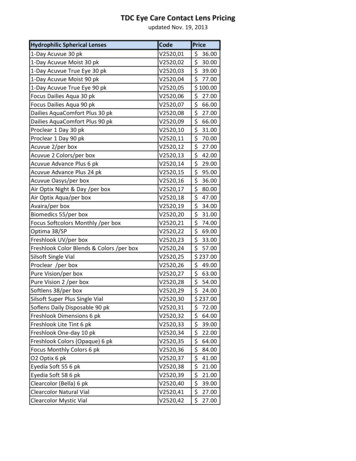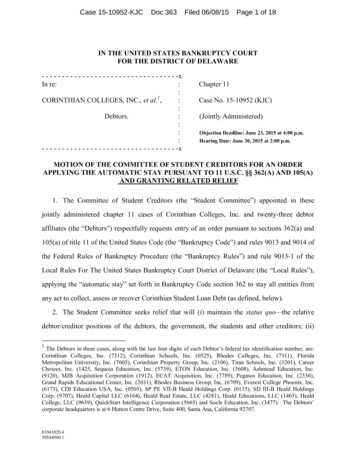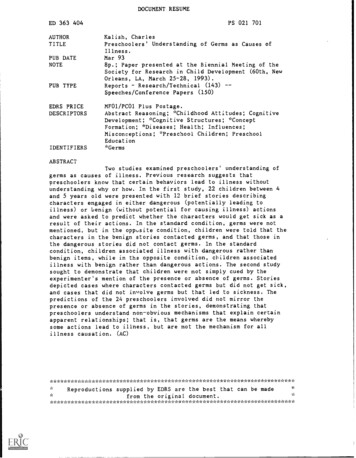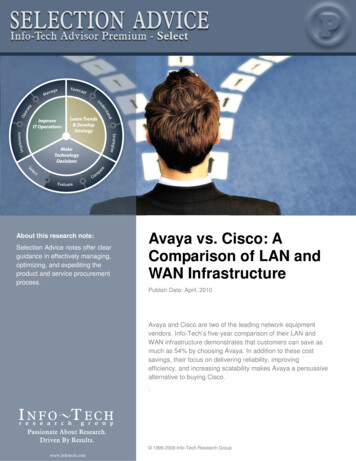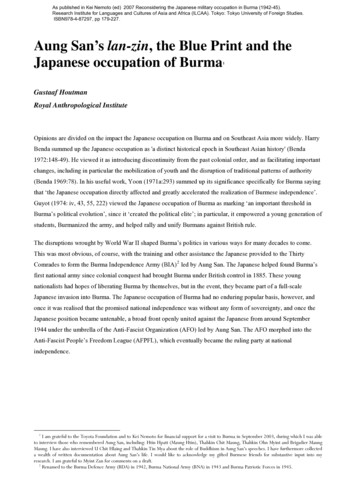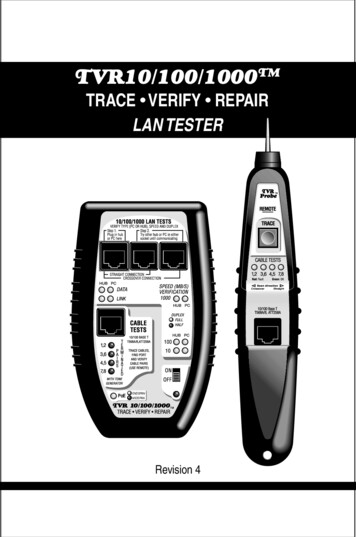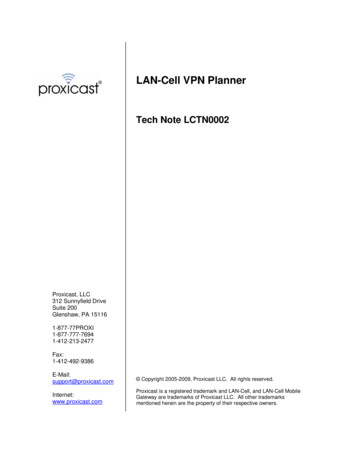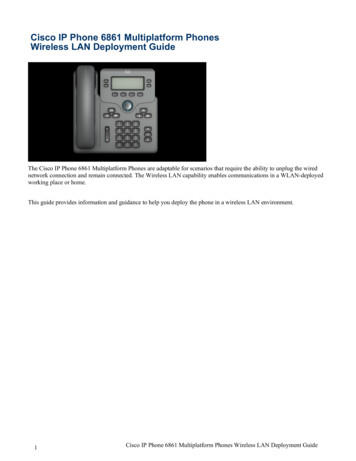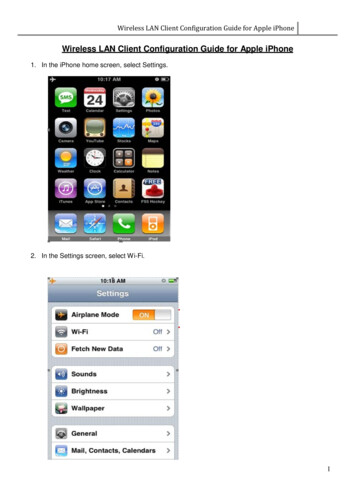
Transcription
Introduction to LANTDC 363Week 4Connecting LAN to WANBook: Chapter 7TDC363-0401/24/081Outline Wide Area Network (WAN): definitionWAN TopologiesChoices of WAN technologies Dial-upDialISDNT1Frame RelayDSLRemote network connectionsMidtermTDC363-0401/24/082What is WAN?Internet and . Relatively long physical distance2. Requiring a service provider (carrier)01/24/08TDC363-0431
WAN InterfaceCustomerrouterCPEE tEnterprisei NNetworktkDemarcationDtipointCarrier 1/24/084WAN Topologies Wide area network (WAN) topologiesPeer-toPeerto-peerRing StarSt r Mesh Tiered (Hierarchy) TDC363-0401/24/085Wide Area Network (WAN)Topologies (bus)T1Note: You cannot use DSL for interoffice communications.01/24/08TDC363-0462
Ring Topology on WAN Each site is connected to two other sites so thatentire WAN forms a ring patternISDN01/24/08TDC363-047Star Topology on WAN Single site acts as the central connection point forseveral other points01/24/08TDC363-048Meshed Topology on WAN Many directly interconnected locations forming a complexmesh01/24/08TDC363-0493
Tiered Topology on WAN Sites connected in star or ring formations are interconnected atdifferent levels, with interconnection points organized intolayersTDC363-0401/24/0810WAN Technology Dial-up (PSTN)DialISDN (BRI)ISDN (PRI) – voice onlyX 25 – out of dateX.25Frame RelayLeased Line (T(T-carrier)Leased Line (OC(OC-x)ATM – too expensive xDSLCable ModemSONET – not forenterprise EthernetWirelessTDC363-0401/24/0811Technology TNISDNDS3/T301/24/08X.25Frame RelayATMOC-3cOC-xPacketSwitchingEthernetQ: where is IP?TDC363-04xDSL124
PSTN(Public Switched Telephone Network Designed for voice traffic (not for data traffic) Also called plain old telephone service(POTS) PSTN for WAN connection: Modem (V.92) ISDN Downlink: 53 kbps, uplink: 48 kbpsTDC363-0401/24/0813PSTN to InternetTandem SwitchPSTNLocal SwitchmodemLocal serverISPRemoteAccess Server(modem pool)14ISDN BRI (Basic Rate Interface) International standard for transmitting data overdigital linesBRI: Basic Rate Interface (2B D)A variety of ISDN using two 6464-kbps bearer (B)channels and one 1616-kbpsp data ((D)) channel,, asindicated by the following notation:Through bonding, the two 6464-kbps channels canbe combined to achieve an effective throughputof 128128-kbpsISDN PRI (23B D) over T101/24/08TDC363-04155
ISDN Network ConnectionsService ProviderBRI2B DCustomer ABRICustomer B2B DPRIPSTNCentral Office23B DBRI2B DCf. Fig.7-10, 7-11Customer C01/24/08TDC363-0416T-Carriers The most common TT--carrier implementations are T1and T3Signal level (DS0, DS1, etc.) ANSI standard for TT--carrier technology that refers to itsPh i l layerPhysicallelectricall t i l signalingi li characteristicsht i ti DSO (digital signal, level 0) Fractional T1 (FT1, n 64K) 01/24/08Equivalent of one voice channel (64K)Arrangement allowing an organization to use only somechannels on a T1 line, paying for what they useTDC363-0417Types of TT-CarriersT1: 64K 24 1.536 vs. (24 8 1) 8K 1.544Mchannels: telephone calls01/24/08TDC363-04186
T-Carrier Connectivity Wiring CSU/DSU (Channel Service Unit/Data Service Unit) CSU provides termination for the digital signal and ensures connection Can use unshielded or shielded twistedtwisted-pair copper wiringintegrity through error correction and line monitoringDSU converts the digital signal used by CPE into the digital signal sent viathe outside cabling to the carrier.TDC363-0401/24/0819T1: DataData-only ServiceCustomerrouterCSU/DSUEnterprise NetworkT1Carrier NetworkInternetchannelizedcore routerDS3(built-in CSU/DSU)multiplexerTDC363-0401/24/0820DS3 Deployment Typically, fiber (often deployed as STS1/STS3) is used totransport the signals from the central office to the premisewiring closet where the STS1/STS3 fiber line is segmented intosingle or multiple DS3 coaxial lines for further deployment toindividual offices or ibercoaxTDC363-04217
Need Higher Data Rate T1: 1.544M bpsN T1 where N 1, 2, 4, 6, 8DS3 28 T1 45M bpsOC--3 3 DS3 155M bpsOCbOC--12 4 OCOCOC-3 622M bpsOC--48 4 OCOCOC-12 2.4G bpsOC--192 4 OCOCOC-48 10G bpsOC--768 4 OCOCOC-192 40G bpsTDC363-0401/24/0822Packet Switching Service X.25 Analog, packetpacket--switched LAN technology optimized for longlong--distance datatransmissionFrame Relay Updated (and simplified) digital version of X.25 Variable rates: from 56K bps to 1.544M bps (new standards to 45M bps)TDC363-0401/24/0823Frame Relay OverviewDCE orFrameRelay SwitchFrame RelayCSU/DSURouterEthernet Virtual circuit connections Connection--oriented serviceConnection 01/24/08One physical circuitMultiple virtual circuitsPermanent Virtual Circuit (PVC)TDC363-04248
Frame Relay (cont.) Address: Data Link Connection Identifier(DLCI), 1010--bit, local significance.CIR (committed information rate)Guaranteed minimum amount of bandwidthselected when leasing a frame relay circuitCan burst higher than CIRUsers get more than they pay for. bburstt(512k)CIR(768k)TDC363-0401/24/0825Why Frame Relay?(compared with T1) X.25 too much overhead, ATM too expensiveA popular service for WAN Switched technology: The paragraph in the book is incorrect. (p. 355)notot sesensitives t ve to ddistancesta ce in pricingp c gCheaper than T1 for long distance Physical Connection: point to multimulti--points Logical Connection: point to point Security: as good as PSTN (which is very secure) 01/24/08Significant cost saving for a mesh topologyAs secured as T1TDC363-0426Digital Subscriber Lines (DSL)Uses advanced data modulation techniques toachieve extraordinary throughput over regularphone lines (2(2-wire or 44-wire) DSL can span only limited distances.distances DSL types can be divided into two categories: Asymmetrical (download upload) Symmetrical (download upload) 01/24/08TDC363-04279
Types of DSLADSL: Asymmetric DSLHDSL: High Bit Rate DSL (4-wire)SDSL: Symmetric (or Single line [one pair]) DSLVDSL: Very High Bit Rate DSL (not for WAN)New standards:HDSL2 (2-wire)g.shdsl, symmetricNew: ADSL2 and ADSL2 TDC363-0401/24/0828DSL Connectivity Once inside the customer’s home or office, the DSL line must pass through aDSL modemOne RJRJ--11 port to PSTNOne RJRJ--45 port to home/office ote: ADSL requires a splitterat customer premiseDSLAM: DSL Access Multiplexer01/24/0810
DSL rvoiceswitchcore router (ATM Switch)DSLAMfilterInternetNote: G.lite does not need a splitter at customer premiseTDC363-0401/24/0831Cable Modem Cable connections require that the customer use a special cablemodem, a device that transmits and receives digital signals fortransmission and reception via cable wiringTDC363-0401/24/0832Cable Modem Network InfrastructurefiberHFC: Hybrid Fiber Coax01/24/08TDC363-043311
Notes on Cable Modem Shared Medium Performance degradation if everyone is surfing.Security Concern Infrastructure Comparison and Competing with xDSL Not available to the business communityThere is no right answer.Note: Any packet switching technology allow multiple users to share themedia. The goal is to improve the utilization of the media. Whereverthere is resource sharing, there is potential bottleneck. The question iswhere the media is being shared.TDC363-0401/24/0834SONET in Metro NetworkCore RouterADMADMCarrierCentralOfficeMetro SONET RingADMADMADMAccess RingAccess RingAccess RingADMADMT1c.f. Fig. 7-18CPETDC363-0401/24/0835Add--Drop Multiplexer (ADM)AddADMADMADMSONET RingADMPass throughdropaddc.f. Fig. 7-1901/24/08TDC363-043612
Notes on SONET SONET is a popular technology (and widely deployed)for a carrier to build its metro backbone.It may also used by an enterprise in a campus network.GGovernmentalsol bbuildsild itsi own SONETST backbone.b kbSONET is not the technology to access the Internet.An enterprise may connect its SONET to a carrierSONET via a leased trunk (OC(OC-3 or higher).TDC363-0401/24/0837SONET for Enterprise andResidential UsersADMSONET Ring(owned by carrier)ADMADMADMThe ADM is owned and maintained by a carrier, but itcould be physically located at a company premise, orit could be at a multi-tenant environment (MTE).Example of MTE: office building, apartment complex.TDC363-0401/24/0838Remote Connectivity Need: access private resources on the corporate network Remote access methods: Direct dial to the LAN Terminal Services (p. 386) Through a browser, a user at home or on the road connects to a LANwhose files are made visible to the Web through Web server softwareVirtual Private Network (VPN) 01/24/08Software running on both remote user’s computer and LAN computerallows remote user to “take over” the LAN workstation.Web Portals (p. 387) The computer dialing into the LAN becomes a remote node on thenetwork (see the slide on RAS/modem pool)a private data network over the public InternetTDC363-043913
Virtual Private Networks (VPNs) VPN is a private network over a public network(internet). A VPN may or may not be IPIPbased.TDC363-0401/24/0840Remote AccessRemote Access ServerSecurityServerPSTNIntranetInternetVPN GatewayTerminalserver01/24/08TDC363-0441Review Questions 01/24/08What are the characteristics distinguishing WANfrom LAN?Speed of TT--carrier and OCOC-xComparison of T1 and Frame Relay. Give ascenario that you will use T1 and another scenario touse Frame Relay.RelayDraw a network diagram to show the T1 connectionto the Internet. (CSU/DSU router )What is CSU/DSU?What is the addressing scheme of frame relay? Isthere an addressing scheme for T1?Comparison of different DSL and their speeds.TDC363-044214
Review Questions Describe the differences between ADSL and ADSL.lite(or G.lite).What is the network device to distribute traffic to/fromSONET?Given a network diagram of three locations connectedvia Frame Relay, design the IP subnet scheme.What are the choices of remote access?What is VPN?TDC363-0401/24/0843Midterm Exam 02/05 (Tuesday), 01:30pmExam time: 90 minutesExam seating will be given by the instructor.Exams are closed book, closed notes. No makemake-up examStudy Guide: 01/24/08C l lCalculatoriis allowedlldbbut no palml computer.You are allowed to bring a 22--page note (double sides)Review questionsHomeworkTDC363-044415
WAN Technology DialDial--up (PSTN . The most common TThe most common T--carrier implementations are carrier implementations are T1 and T3 Signal level (DS0, DS1, etc.) ANSI standard for TANSI standard for T--carrier technology that refers to its carrier technology that refers to its Ph i l l l t i l i li h t i ti 01/24/08 TDC363-04 17 Physical layer electrical signaling characteristics DSO .
